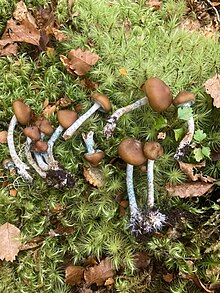
Back Psilocybe makarorae CEB Psilocybe makarorae ID Psilocybe makarorae Portuguese Psilocybe makarorae Swedish Psilocybe makarorae SZL Psilocybe makarorae WAR
| Psilocybe makarorae | |
|---|---|

| |
| Scientific classification | |
| Domain: | Eukaryota |
| Kingdom: | Fungi |
| Division: | Basidiomycota |
| Class: | Agaricomycetes |
| Order: | Agaricales |
| Family: | Hymenogastraceae |
| Genus: | Psilocybe |
| Species: | P. makarorae
|
| Binomial name | |
| Psilocybe makarorae P.R.Johnst. & P.K.Buchanan (1995)
| |
Psilocybe makarorae is a species of psilocybin mushroom in the family Hymenogastraceae. Officially described as new to science in 1995, it is known only from New Zealand, where it grows on rotting wood and twigs of southern beeches. The fruit body (mushroom) has a brownish cap with lighter coloured margins, measuring up to 3.5 cm (1.4 in) wide. The cap shape is either conical, bell-shaped, but as the mushroom grows, it expands to become convex, and it features a prominent umbo. Although the whitish stem does not form a true ring, it retains remnants of the partial veil that covers and protects the gills of young fruit bodies. P. makarorae mushrooms can be distinguished from the similar North American species Psilocybe caerulipes by microscopic characteristics such as the presence of cystidia on the gill faces (pleurocystidia), and cheilocystidia (found on the gill edges) with more elongated necks. Based on the bluing reaction to injury, P. makarorae is presumed to contain the psychedelic compounds psilocybin and psilocin.
© MMXXIII Rich X Search. We shall prevail. All rights reserved. Rich X Search